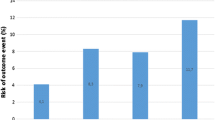Abstract
The study was performed to determine whether age, cardiovascular risk factors or the stroke syndrome might define patients with embolic stroke for whom transoesophageal echocardiography (TEE) would prove to be useful. Of 256 patients from the Klosterneuburg Stroke Data Bank, 105 (40%) were included because of suspected embolic stroke (59 female, 46 male, mean age 64 years). A positive TEE finding was defined as the presence of left heart thrombus, valvular vegetation, right to left shunting or spontaneous echo contrast. TEE detected potential sources for embolism in 35 of the 105 patients. These were left atrial/appendage thrombi (n = 18), valvular vegetations (n = 4), right to left shunting (n = 10), and spontaneous echo contrast (n = 5). Only the presence of atrial fibrillation showed a significant association with the presence of a cardiac source of embolism (18/35 versus 22/70,P < 0.02). Age, cardiac disease, cardiovascular risk factors and the stroke syndrome did not help in distinguishing stroke patients with and without a positive TEE finding.
Similar content being viewed by others
References
Amarenco P, Duyckaerts C, Tzourio C, Henin D, Bousser M, Hauw J (1992) The prevalence of ulcerated plaques in the aortic arch in patients with stroke. N Engl J Med 326:221–225
Bisiach E, Perani D, Vallar G, Berti A (1986) Unilateral neglect: personal and extrapersonal. Neuropsychologia 24:759–767
Bisiach E, Vallar G, Perani D, Papagno C, Berti A (1986) Unawareness of disease following lesions of the right hemisphere: anosognosia for hemiplegia and anosognosia for hemianopia. Neuropsychologia 24:471–482
Black IW, Hopkins AP, Lee LC, Walsh WF, Jacobson BM (1991) Left atrial spontaneous echo contrast: a clinical and echocardiographic analysis. J Am Coll Cardiol 18:398–404
Bogousslavsky J, Cachin C, Regli F, Despland P, Van Melle G, Kappenberger L (1991) Cardiac sources of embolism and cerebral infarction - clinical consequences and vascular concomitants: the Lausanne stroke registry. Neurology 41:855–859
Brainin M (1994) Overview of stroke data banks. Neuroepidemiology 13:250–258
Brainin M, Seiser A, Steiner M, Dastmaltschi Y (1994) Silent cerebral infarction in stroke patients: results from the Klosterneuburg stroke data bank (Austria). J Stroke Cerebrovasc Dis 4:13–17
Cujec B, Polasek P, Voll C, Shuaib A (1991) Transesophagealechocardiography in the detection of potential cardiac source of embolism in stroke patients. Stroke 22:727–733
Damasio H (1983) A computed tomographic guide to the identification of cerebral vascular territories. Arch Neurol 40:138–142
Daniel WG, Angermann C, Engberding R, Erbel R, Hanrath P, Iliceto S, Kasper W, Visser CA (1989) Transesophageal echocardiography in patients with cerebral embolic events and arterial embolism — a European multicenter study (abstract). Circulation [SupplI]:II-473
Daniel WG, Erbel R, Kasper W, Visser CA, Engberding R, Sutherland G, Grube E, Hanrath P, Maisch B, Dennig K, Schard M, Kremer P, Angermann C, Iliceto S, Curtius J, Mügge A (1991) Safety of transesophageal echocardiography: a multicenter survey of 10,419 examinations. Circulation 83:817–821
Folstein MF, Folstein SE, McHugh PR (1975) Mini-Mental state. A practical method for grading the cognitive state of patients for the clinician. J Psychiatr Res 12:189–198
Gardner MJ, Altman OG (1989) Statistics with confidence. British Medical Journal, London
Hagen PT, Scholz DG, Edwards WD (1984) Incidence and size of patent foramen ovale during the first 10 decades of life: an autopsy study of 965 normal hearts. Mayo Clin Proc 59:17–20
Hofmann T, Kasper W, Meinertz T, Geibel A, Just HJ (1990) Echocardiographic evaluation of patients with clinically suspected arterial emboli. Lancet 336:1421–1424
Jacobs NH, Whyte S, Kelleher AD, Juarez CC, Garrick R, Feneley MP (1990) Limited role of transesophageal echocardiography in unselected patients with cerebral ischemic events (abstract). Circulation [Suppl III]:110
Kitmer SJ, Sharkness CM, Price TR, Plotnick GD, Dambrosia JM, Wolf PA, Mohr JP, Hier DB, Kase CS, Tuhrim S (1990) Infarcts with a cardiac source of embolism in the NINCDS stroke Data Bank: historical features. Neurology 40:281–284
Lee RJ, Bartzokis T, Yeoh TK, Grogin HR, Choi D, Schnittger I (1991) Enhanced detection of intracardiac sources of cerebral emboli by transesophageal echocardiography. Stroke 22:734–739
Levine RA, Stathogiannis E, Newell JB, Harrigan P, Weyman AE (1988) Reconsideration of echocardiographic standards for mitral valve prolapse: lack of association between leaflet displacement isolated to the apical four chamber view and independent echocardiographic evidence of abnormality. J Am Coll Cardiol 11:1010–1019
Marks AR, Choong CY, Sanfilippo AJ, Ferre M, Weyman AE (1989) Identification of high-risk and low-risk subgroups of patients with mitral-valve prolapse. N Engl J Med 320:1031–1036
Pearson AC, Labovitz AJ, Tatinemi S, Gomez CR (1991) Superiority of transesophageal echocardiography in detecting cardiac source of embolism in patients with cerebral ischemia of uncertain etiology. J Am Coll Cardiol 17:66–72
Pop G, Sutherland GR, Koudstaal PJ, Sit TW, Jong G de, Roelandt JR (1990) Transesophagealechocardiography in the detection of intracardiac embolic sources in patients with transient ischemic attacks. Stroke 21:560–565
Seward JB, Khanderia BK, Edwards WD, Oh JK, Freeman WK, Tajik J (1990) Biplanartransesophageal echocardiography: anatomic correlations, image orientation and clinical applications. Mayo Clin Proc 65:1193–1213
Stöllberger C, Schneider B, Abzieher F, Wollner T, Meinertz T, Slany J (1993) Diagnosis of patent foramen ovale by transesophageal contrast echocardiography. Am J Cardiol 71:604–606
The Cerebral Embolism Task Force Report (1989) Arch Neurol 46:727–743
Author information
Authors and Affiliations
Rights and permissions
About this article
Cite this article
Stöllberger, C., Brainin, M., Abzieher, F. et al. Embolic stroke and transoesophageal echocardiography: can clinical parameters predict the diagnostic yield?. J Neurol 242, 437–442 (1995). https://doi.org/10.1007/BF00873546
Received:
Revised:
Accepted:
Issue Date:
DOI: https://doi.org/10.1007/BF00873546




